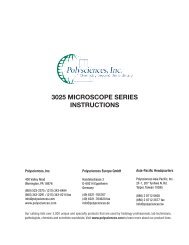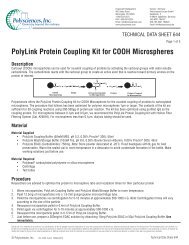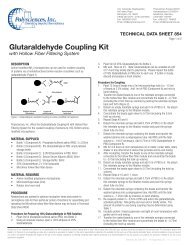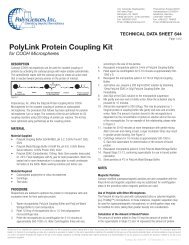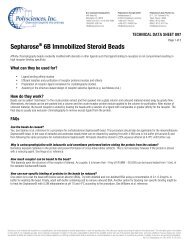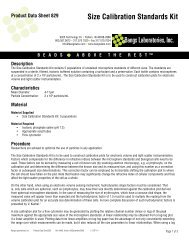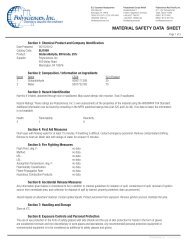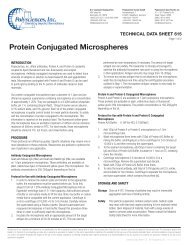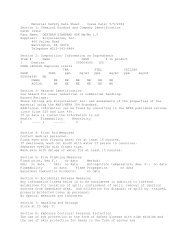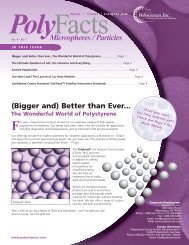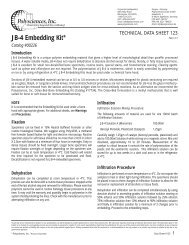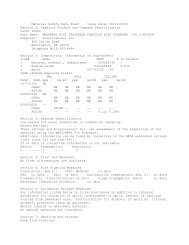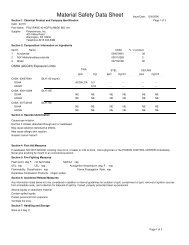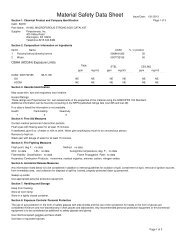BioSciences - Polysciences, Inc.
BioSciences - Polysciences, Inc.
BioSciences - Polysciences, Inc.
Create successful ePaper yourself
Turn your PDF publications into a flip-book with our unique Google optimized e-Paper software.
324<br />
Electronic Adhesives & Encapsulants<br />
CONFORMAL COATING: Low viscosity polymer coating typically<br />
spun or sprayed onto a device or semiconductor. These coatings<br />
protect the devices from the environment or provide electrical<br />
insulation value. They do not protect well against physical shock as<br />
they are only a thin coating.<br />
CTE (Coefficient of Thermal Expansion): How much a<br />
material grows when heated (and shrinks when cooled). The unit<br />
of measure is parts per million/per degree centigrade. The CTE<br />
differences (CTE mismatch) among the materials in a semiconductor<br />
package will cause stresses as the part is exposed to temperature<br />
changes in its working life. In most cases, it is useful for an epoxy<br />
connecting two materials to have a CTE that falls between the<br />
CTE’s of the materials being joined.<br />
CTE’s of Common Materials ppm/C<br />
Silica 1<br />
Silicon Die 2.5 to 4<br />
Alumina 6.5<br />
Gold 14<br />
FR4 Substrate 14<br />
Copper 17<br />
BT Laminate 20<br />
Solder Ball 25<br />
Unfilled Polymer 60 or higher<br />
CURE: Non-specific term that is widely used to mean the solidification<br />
of a polymer. Curing can be accomplished by applying heat or UV<br />
light. Several intermediate steps take place during curing that also<br />
have non-specific definitions. When the outside layer of the liquid<br />
forms a rubbery coating this is called skinning. When the entire<br />
liquid material is solid, but has not yet achieved stable mechanical<br />
properties this is called gelling. When the material reaches its final<br />
mechanical properties it is said to be cured.<br />
CURING PROFILE: Sometimes referred to as cure cycle or cure<br />
schedule, defines the time and temperature required to change<br />
the state of a material to achieve its best-desired performance<br />
characteristics.<br />
DAM: A wall of material around the perimeter of a device. The<br />
dam is formed by dispensing a high viscosity material through a<br />
single nozzle that traces a pattern around the device. The dam’s<br />
main function is to contain a low viscosity fill material that is<br />
applied to encapsulate the device.<br />
DIE: A single semiconductor cut from a wafer.<br />
For more information please call (800) 523-2575 or visit: www.polysciences.com<br />
DIE ATTACH: Adhesive that bonds the semiconductor die to<br />
the substrate. Can be thermally conductive or nonthermally<br />
conductive.<br />
DIELECTRIC CONSTANT: Ratio of the capacitance of a material<br />
(materials that do not conduct electricity) to the capacitance of air.<br />
A measure of the insulating strength of a dielectric material.<br />
DIELECTRIC LOSS: Electric energy transformed into heat in<br />
a dielectric subjected to changing electric fields. The amount of<br />
electrical energy lost to the dielectric.<br />
DSC (DYNAMIC SCANNING CALORIMETER): Analytical<br />
instrument that measures the heat absorbed or released by a<br />
material as it’s temperature is raised at a controlled rate. A significant<br />
change in the graph of this measure indicates a chemical reaction<br />
is occurring. This measure is used to determine the temperature<br />
at which an epoxy material will change from liquid to solid. This<br />
instrument also measures the percentage cure of epoxy materials.<br />
DTA (DYNAMIC THERMAL ANALYSIS): DTA is an analytical<br />
instrument used to measure the effects of temperature on the<br />
performance of materials. It is key to determining the temperature<br />
at which a material changes phase, such as from a glass-like<br />
solid to a soft, rubbery condition. The temperature at which this<br />
transition occurs is referred to as the glass transition temperature,<br />
or Tg. This instrument can also measure modulus. It is an extension<br />
to the older means of using a TMA (Thermal Mechanical Analyzer)<br />
for some of these measurements.<br />
ENCAPSULANT: A material that seals or covers a semiconductor<br />
to provide mechanical and environmental protection. Typical<br />
materials are: molding compound, glob top, dam & fill and potting<br />
compound.<br />
EPOXY: Family of thermosetting resins that are used as the media<br />
for bonding and protecting semiconductor devices. The main<br />
advantages of epoxy are the ability to form strong bonds to many<br />
surfaces, low processing temperature and low cost. Epoxies come<br />
in many variations with many different properties.<br />
EPOXY ANHYDRIDE: Anhydride is the curing agent most<br />
commonly used in semiconductor materials such as die attach<br />
adhesive. As a curing agent, it not only causes the polymerization<br />
reaction to occur, it becomes a part of the finished compound. The<br />
nature of the anhydride reaction is such that it starts to cause the<br />
epoxy to change to a solid (gel) at room temperature without the<br />
addition of heat.



